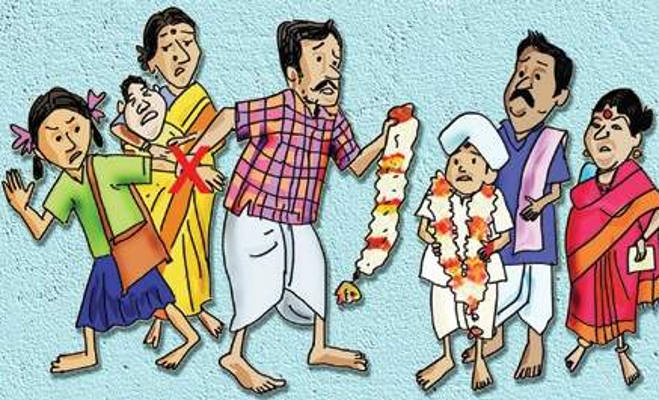Vaishnavi Nair
Child marriage, a strongly ingrained societal practice, exemplifies severe gender inequality and prejudice. It is the outcome of multiple socio-economic factors in our country. In communities where the practise is so widespread, marrying a girl at a young age is a part of the broader set of cultural perceptions and beliefs that demonstrate a disregard for a girl child’s human rights.
Child marriages are mostly favoured by low-income families in order to cut expenses and enable the family’s financial power by making money accessible for sustenance, wellness, and even education of the males born to the household. According to this viewpoint, it is not incorrect to deduce that girls are considered personal possessions or property at the disposal of their parents because they are all intended to be wedded off at the earliest possible time.
According to UNICEF[1], 650 million women in the world today were married before reaching the age of 18. India has 223 million child brides, accounting for one-third of the total. More than a million young girls under the age of 18 are married off in India each year, making it a home to the highest number of child brides in the world. While the proportion of child brides before the age of 18 has decreased from 47% to 27% between 2005-2006 and 2015-2016, it is still significant.
Child marriages have their own set of consequences, including health issues for women as a result of early pregnancy, high infant mortality rates, lack of skills and career possibilities leading to reliance on the spouse, further degradation in women’s prestige, and a vicious circle of violence against women.
One of the first steps taken by the government to curb the issue of child marriage dates back to the pre-independence era. The Child Marriage Restraint Act of 1929 was adopted by the British government. Its major purpose was to reduce the horrors perpetrated on adolescent women who were unable to withstand the burden of marriage and to prevent premature deaths.
This legislation defined a male child as being 21 years or younger, and a female child as being 18 years or younger, which was 18 years and 14 years earlier. The punishment for a male member between the ages of 18 and 21 was imprisonment for 15 days or a fine of Rs. 1,000 or both. The punishment authorized for a parent or guardian of a child involved in a child marriage was up to three months in jail or a fine. However, it did not render the marriage null and void on its own. It only imposed sanctions, the penalty was minimal, and the fee was meagre as well.
As a consequence of the incompetency of the Child Marriage Restraint Act of 1929, a new piece of law, the Prohibition of Child Marriage Act of 2006, was introduced to supersede it.
This Law recognized child marriage as the marriage of a boy under the age of 21 years and a female under the age of 18 years. The Act also made reforms, such as increasing the mandatory sentence of two years in jail and/or a fine of up to one lakh rupees. If the marriage is declared null and void, the Act mandates the return of any money, assets, presents, and ornaments supplied to the other party, as well as an order of support for the former wife. The Act also allows for government-appointed Child Marriage Prohibition Officers to act to prevent child weddings; while this is a fine idea, in theory, it is uncertain about to what degree they are actually in action.
Most of the previous Act’s issues were legally resolved with the implementation of the PCMA in 2006, but the cultural and social problem of child marriage continued. Some of the reasons for the practice, according to the Karnataka State Consultation on Child Marriage, include a lack of awareness of existing laws and a lack of proactive enforcement officers and administrators to deal with such occurrences.
The notable shortcomings of the act are as given below:
- Child marriage is still not void but voidable-
Even though child marriage is regarded permissible under personal law, religious institutions must follow the severe standards of the 2006 Act, which allows child marriages to be voidable at the child’s discretion. According to the Act, child marriage is only voidable if a petition for annulment is filed in district court, rendering them void only when the child is kidnapped/taken away from the care of a guardian, in circumstances of force, fraud, or trafficking, and if done in defiance of an injunction. The fact that the Act does not instantly deem child marriages void, but instead makes them voidable voluntarily, is problematic.
- The child bears the onus of proof to challenge validity-
In their own capacity, only the child bride/groom can file a petition to annul their marriage. If the petitioner is a minor under the PCMA (female under the age of 18, male under the age of 21), the petition can only be submitted with the aid of the child marriage prohibition officer by a caretaker or next closest friend (who must be an adult of 18 years or older).
This type of access to justice appears perfect in principle, but not in actuality because many children suffer opposition and physical restraint by their own families, as well as threats of retaliation for reporting the violation by husbands and in-laws, as a result of cultural conventions and biases surrounding the subject of child marriage. In many cases, it is the caretaker that forces children into this while they are young. This is a critical issue that should be tackled primarily.
- Criminalizing the parent/caregiver without considering the circumstances that led to the child marriage-
It is controversial that the Act criminalizes those who execute child marriages, usually parents or caretakers, without analysing the deeper reasons for child marriage, which could include economic inequality, poor educational opportunities, for their daughters’ security etc. However, several non-governmental organizations have recommended that government employees who fail to report such marriages in their jurisdiction should be penalized. This should be taken more seriously into consideration than criminalizing members of the family who were vulnerable to societal pressure.
- Conflicts caused because of Personal laws-
The PCMA’s execution is additionally hampered by personal law immunity because many communities’ personal laws still permit child marriages while the PCMA strives to ban them, the contradiction creates major legal issues.
The Supreme Court stated that it is evident that when amending multiple laws, other laws are “forgotten” and no subsequent amendments are made. According to the report, both the Hindu Marriage Act of 1955 and the Dissolution of Muslim Marriages and Divorce Act of 1939 should have been modified when the PCMA was enacted, but this was not accomplished.
- Registration of every child marriage is not compulsory-
Marriage registration is not obligatory under the PCMA, resulting in a large number of undocumented underage weddings. The Law Commission’s 2017 report titled ‘Compulsory Registration of Weddings,’ as well as the Supreme Court in Smt. Seema Vs. Ashwani Kumar[2], stated that mandatory registration of marriages in each state would be a step in the right direction. They said that underage marriage was still common in many sections of the country.
While preventing child marriage in India is a long-term objective that entails altering societal norms and patriarchal views, decreasing poverty, and boosting educational chances for girls, the country still has a long way to go in terms of amending its laws. This social evil must be eradicated legally, with harsher punitive penalties and responsibility checks for authorities constituted under the PCMA Act. Legislators and enforcement agencies must address this serious issue if minors are to be better protected.
Views are Personal.
(Author is a First-Year Law Student at Kirit P. Mehta School of Law, NMIMS, Mumbai)
******
REFERENCES:
“To Root Out Child Marriage, Existing Laws Need Tightening.” https://thewire.in/rights/child-marriage-laws-india (last visited: 30.05.2021)
“Child marriage in India persists amidst child protection laws..” 15 Apr. 2021, https://legaladviceguru.com/child-marriage-in-india/ (last visited: 30.05.2021)
“Legal loopholes, cultural mores make annulment of a child….” 19 Sept. 2018, https://wap.business-standard.com/article-amp/current-affairs/legal-loopholes-cultural-mores-make-annulment-of-child-marriage-arduous-118091801417_1.html (last visited: 30.05.2021)
“To Root Out Child Marriage, Existing Laws Need Tightening.” https://thewire.in/rights/child-marriage-laws-india (last visited: 30.05.2021)
“FAILURE OF THE PROHIBITION OF CHILD MARRIAGE ACT, 2006….” 24 Jan. 2019, https://nujshsfbridgeproject.wordpress.com/2019/01/24/failure-of-the-prohibition-of-child-marriage-act2006/ (last visited: 30.05.2021)
******
[1] UNICEF INDIA, End child marriage, https://www.unicef.org/india/what-we-do/end-child-marriage
[2] Smt. Seema v. Ashwani Kumar AIR 2006 SC 1158
Disclaimer: The views and opinions expressed in the articles on this website are those of the authors and do not necessarily reflect or represent the views and opinions held by the website owner.

